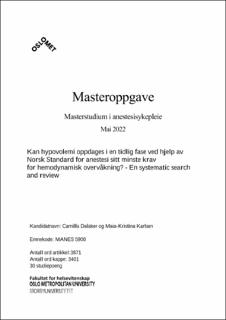| dc.contributor.advisor | Wolf, Axel | |
| dc.contributor.author | Camilla, Dalaker | |
| dc.contributor.author | Karlsen, Maia-Kristina | |
| dc.date.accessioned | 2022-09-07T12:46:04Z | |
| dc.date.available | 2022-09-07T12:46:04Z | |
| dc.date.issued | 2022 | |
| dc.identifier.uri | https://hdl.handle.net/11250/3016344 | |
| dc.description.abstract | Bakgrunn: Det kan være livreddende å oppdage hypovolemi tidlig, slik at tiltak kan iverksettes for å reversere sjokkutviklingen. Takykardi og hypotensjon er ikke tidlige indikatorer på hypovolemisk sjokk. Anestesisykepleieren skal observere, forstå og tolke monitoreringsdata slik at tiltak kan iverksettes. Det er ikke avdekket noen systematisk oversikt om oppdagelse av hypovolemi i en tidlig fase ved hjelp av hemodynamisk overvåkning som er minste krav for pasienter i generell anestesi, i følge Norsk Standard for anestesi.
Hensikt: Vi undersøker hvordan hypovolemi i en tidlig fase kan oppdages ved hjelp av hemodynamisk overvåkning som ifølge Norsk Standard for anestesi inngår i minste krav for pasienter i generell anestesi.
Metode: Denne studien er en systematic search and review. Databasesøk ble utført i MEDLINE, CINAHL og Cochrane. Blindet screening ble utført av to forfattere med bakgrunn i inklusjons- og eksklusjonskriteriene. Kvaliteten på studiene ble kritisk vurdert med sjekklisten for Analytical Cross Sectional Studies fra Joanna Briggs Institute. Data fra studiene ble samlet i en litteraturmatrise.
Resultater: Litteratursøket fant 1783 artikler. Seks studier er inkludert i arbeidet. Samtlige omhandler verktøyet pulsoksymetri for oppdagelse av hypovolemi. Studiene viser at kurvevariasjoner fra standard pulsoksymetri kan være en tidlig indikator på hypovolemi.
Konklusjon: Pulseoksymetri er enkelt, tilgjengelig og innebærer ingen risiko for pasienten, og kan være et godt hjelpemiddel for å oppdage hypovolemi i en tidlig fase. Disse funnene kan potensielt bidra til å bedre pasientsikkerheten ved at hypovolemi oppdages tidligere. | en_US |
| dc.description.abstract | Hypovolemia can be a life-threthening condition if it is not discovered and reversed. It is important to detect hypovolemia early to ensure patient safety. Profound signs of hypovolemia like tachycardia and potentially hypotension do not occur before the patient has lost 15-30 % of total blood volume. There is no systematic review about the early onset of hypovolemia using hemodynamic monitoring included in the minimum Norwegian standard for patients in general anesthesia.
Purpose: The aim of this study is to investigate whether certain methods of hemodynamic monitoring can detect hypovolemia before the onset of tachycardia and hypotension. Hemodynamic monitoring tools included in this study equal the Norwegian minimum standard for patients in general anesthesia; pulsoximetry, capnography, ECG and non-invasive or invasive blood pressure.
Method: This study is a systematic search and review of quantitative research. 1783 articles was assessed by title, 107 by abstract and 24 by full text. Six articles were quality assessed using the checklist for Analytical Cross Sectional Studies from Joanna Briggs Institute. Those six articles have acceptable quality and were included in the study. Blinded screening was carried out by two authors based on the inclusion- and exclusion criteria.
Results: The included studies do all reach the conclusion that waveform variations in the curve of a standard puls oximeter give an indication of hypovolemia before the onset of tachycardia and hypotension. The studies do not agree whether forehead, finger or earlobe is the optimal placement of the pulsoximetry probe.
Conclusion: Pulse oximetry curve variations can provide an early indication of the development of hypovolemia, but can not be used as a single diagnostic tool to detect the condition. | en_US |
| dc.language.iso | nob | en_US |
| dc.publisher | OsloMet - Storbyuniversitetet | en_US |
| dc.subject | Hypovolemi | en_US |
| dc.subject | Hemodynamisk overvåkning | en_US |
| dc.subject | Pulsoksymetri | en_US |
| dc.subject | Plethysmografikurver | en_US |
| dc.subject | Search and review | en_US |
| dc.subject | Litteratursøk | en_US |
| dc.subject | Litteraturgjennomgang | en_US |
| dc.subject | Hypovolemia | en_US |
| dc.subject | Hemodynamic monitoring | en_US |
| dc.subject | Pulse oximetry | en_US |
| dc.subject | Plethysmography curves | en_US |
| dc.title | Kan hypovolemi oppdages i en tidlig fase ved hjelp av Norsk Standard for anestesi sitt minste krav for hemodynamisk overvåkning? - En systematic search and review | en_US |
| dc.title.alternative | Can hypovolemia be detected at an early stage using the minimum requirement of hemodynamic monitoring by the Norwegian standard of anesthesia? - A systematic search and review | en_US |
| dc.type | Master thesis | en_US |
| dc.description.version | publishedVersion | en_US |
| dc.source.pagenumber | 52 | en_US |
| dc.subject.nsi | VDP::Medisinske Fag: 700::Klinisk medisinske fag: 750::Anestesiologi: 765 | en_US |
| dc.subject.nsi | VDP::Medisinske Fag: 700::Klinisk medisinske fag: 750::Hematologi: 775 | en_US |
